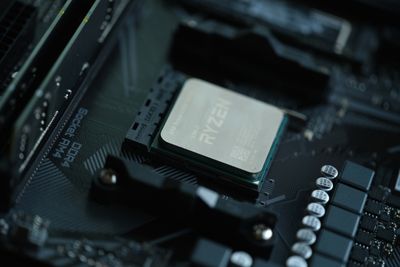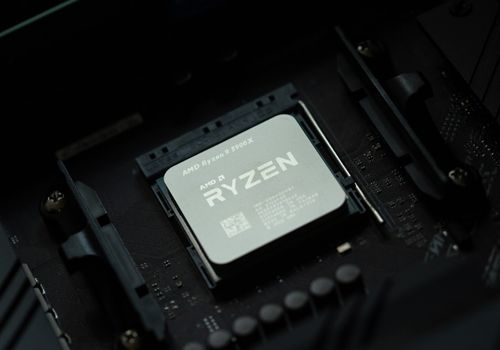
In the modern lineup of AMD processors, the Ryzen 5 series comes closest to Intel Core i5 CPUs in terms of performance and price. However, since the Intel Core i5 and Ryzen 5 lineups contain multiple CPUs across different generations, it's hard to directly compare them. However, if there's any AMD equivalent for the i5, it is the AMD Ryzen 5.
I don't pick sides when it comes to processors. I've used newer and older-generation models of Intel and AMD CPUs, especially because I love trying new tech as it drops. From my own experience over the years, along with benchmarks, I've found the AMD equivalent to Intel Core i5 processors to be the AMD Ryzen 5 product line.
If you're wondering about the CPUs from AMD equivalent to i5, I have put this guide together to show you the basics you need to know. Without further ado, let's get right into it.
Contents
When it comes to Intel Core processors, you can draw a comparison between each product line and an AMD equivalent. In the case of the Core i5, its counterpart is the Ryzen 5 lineup.
The AMD Ryzen 5 family is the product series that most easily compares to the Intel Core i5 options. While there are many generations and models in each family, if you compare the top models within the latest generation, you'll find the CPU performance to be mostly comparable.
The 5th generation of AMD Ryzen 5 chips, running on the Zen 4 architecture, dropped around the same time as the 13th generation of i5 options.
However, while many Intel Core i5 models can be found in each generation for desktops and laptops, there is only a handful of AMD Ryzen 5 CPUs.
For instance, the 5th-gen CPUs for desktops are the AMD Ryzen 5 7600X and 7600, and that's it. For a laptop, your options are either the AMD Ryzen 5 7640HS or 7645HX.
Remember that AMD Ryzen 5 chips with model numbers starting with 7 are part of the 7000 series, but are not necessarily part of the 5th generation of AMD Ryzen processors. For instance, chips like the 7535U and 7520U are part of the 7000 series, but they run on the Zen 3+ and Zen 2 architectures respectively.
For the sake of accurate comparison, we're only going to be comparing 5th-gen AMD Ryzen 5 processors with 13th-gen Intel Core i5 processors.
All Zen 4-based AMD Ryzen 5 CPUs have 6 cores and are capable of hyperthreading just like their Intel Core i5 competitors. This means they can all operate on 12 threads.
However, keep in mind that even though the Ryzen 5 is the AMD equivalent of the Intel Core i5 lineup, they don't use P and E-cores. They just stick to one kind of processor core.
When it comes to clock speed, AMD opts for a higher clock speed around their entire lineup. The lowest base clock speed among the four is 3.8 GHz, which is higher than the highest base clock speed in the current generation of Intel Core i5 processors.
On top of that, they still offer a boost function, which gives you even better performance. The max clock speed ranges from 5.0 GHz to 5.3 GHz.
This means the AMD Ryzen 5 processors offer you excellent core performance, at least on paper.
You might also want to know that these AMD Ryzen 5 CPUs only come with integrated graphics in the laptop models. You're going to need a GPU of your own if you have an AMD Ryzen 5 desktop CPU.
With the mobile AMD Ryzen 5 processors, you'll get either an AMD 760M if you have the Ryzen 5 7640HS, and an AMD 610M if you have the Ryzen 5 7645X processor.
The Intel Core i5 family of processors is the mid-tier option among Intel's CPUs, right between the i3 and i7.
The Intel Core i5 is perfect for people who want some form of balance between their CPU performance and the affordability of the chip.

In 2022, Intel released the 13th gen of the Intel Core i5 processors. These have two types of cores: Performance, or P, cores; and Efficiency, or E, cores. P-cores are employed when your computer is tasked with intense calculations, and E-cores are used when power draw is best kept low.
Besides the power-efficient "U" processors which have 2 Performance CPU cores, the other Intel Core i5 options in this generation have either 4 or 6 cores.
Most Intel Core i5 processors in the 13th gen have 8 E-cores, besides a couple that have 4.
Also, the Intel Core i5 family is capable of hyperthreading on P-cores. This allows more than one "thread" be run on a single core, which effectively lets the CPU do more work at once. In the case of the i5 lineup, each core can run two threads. That means an Intel Core i5 CPU with 6 cores can run 12 threads!
Taking a look at the base clock speed, Intel Core i5 processors in the 13th generation start from 1.3 GHz for the U models and go up to 3.5 GHz.
Then, taking into account the Turbo Boost tech that these processors come with, the max clock speed ranges from 4.5 GHz, even for the U models, to 5.1 GHz on the high end.
All 13th-generation Intel Core i5 CPUs have an integrated graphics card unless they have an "F" in the model name. With the F models, you'll need to have a discrete GPU before you can connect the desktop to a monitor.
The Intel Core processors with integrated graphics opt for Intel UHD Graphics or Iris Xe GPUs.
The performance on these might not be enough for a gaming PC, but they'll get you somewhere with basic titles, and for mild GPU-heavy tasks like modest video editing.
While this breaks down the differences between the AMD Ryzen 5 and Intel Core i5 processors on paper, I get that some people will want to see a more objective view of the real-world performance difference between these two CPUs.
The best way to do this is by looking at benchmark scores.
Using benchmark results, you'll be able to compare the single-core performance and multi-core performance of the current generation of these two CPU lineups and determine which is the better choice for you.

Here's a little crash course on what you need to understand. The single-core performance tells you how much work your PC can do when utilizing only a single core in the whole CPU. A lot of apps still use only one for their tasks.
However, multi-core performance, which is used a lot by productivity programs, shows you the overall performance of your CPU when it is allowed to put as many cores as possible to work.
Keep in mind that multi-core performance will usually be lower than what you'd get by simply multiplying single-core performance. This is simply because there's less of a thermal ceiling when only a single core is working. Multiple cores will heat up at the same time, making the entire CPU hotter quicker, which reduces how much performance each core can squeeze out.
For these benchmarks, we'll be comparing the top desktop models for the Intel Core i5 and its AMD equivalent. So, we'll be looking at the Intel Core i5-13600K against the Ryzen 5 7600X.
When it comes to single-core performance, the Intel Core 15-13600K and the AMD Ryzen 5 7600X are pretty closely matched.
We'll be using the benchmark results from Cinebench R23 to assess the performance of the Intel and AMD chips here.
The single core performance of the 13600K gets a score of 2001. This is followed closely by the AMD Ryzen 5 7600X, with a score of 1964.
Personally, I don't consider that to be enough of a difference to immediately declare processor supremacy in terms of performance.
Now, when it comes to multi-core performance, we'll be using Cinebench R23 for the benchmark once again.
The Core i5-13600K hits an impressive score of 24221, and this is where the Intel processor truly shines when you compare it to the Ryzen 5.
The AMD Ryzen 5 7600X has a score of 15348 on the same benchmark.
When compared, the Intel CPU enjoys a nearly 60% higher score in multi-core performance. If you frequently use applications that take advantage of multi-core processing, such as video or image editing apps, this could be a deciding factor for you.
When putting an AMD Ryzen 5 CPU against a Core i5 CPU, the raw performance isn't the only thing you want to take a look at. The efficiency of the processor, that is, how much juice it consumes when working, is another factor to look at.
We're going to look at the power draw for each processor when under immense stress and when the system is idling.
To put the system under stress, we'll be using Prime95. With the i5, the processor consumes 313 watts of power. In the case of the AMD Ryzen 5 7600X though, energy efficiency is better, with only 227 watts being drawn.
This shows that during heavy use, the Ryzen 5 is more power-efficient, which is especially important if you're using a mobile Ryzen 5 processor model.
Strangely enough, the case changes when you take a look at the power draw when idling.
The AMD Ryzen 5 measured 91.5 watts. However, in this case, the i5 is more efficient with an average energy draw of 73.3 watts.
However, unless you leave your desktop or laptop idling for long durations, I recommend taking the efficiency during actual use into account. If this is the case, you should go for a Ryzen 5 if you want a chip that won't suck up as much energy.

The AMD Ryzen 5 series of processors is equivalent to the Intel Core i5 series. As long as you consider CPUs from each manufacturer that are in similar generations and on the same level, you'll find that their performance is as similar as they get between the brands.
While base clock speed and other specs might not seem that similar, single-core performance is close whether you're using a Ryzen 5 or Core i5. However, single-core benchmarks are only one aspect, and the i5 does much better with multi-core tests.
